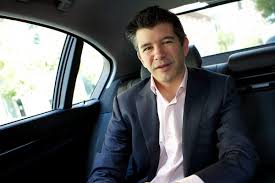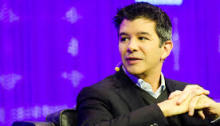At a relatively young age of 38, Travis Kalanick, CEO and co-founder of Uber Technologies, Inc., proved that confidence, competitiveness, and a little bit of creativity are the vital characteristics of a successful entrepreneur and master of adversity.
Travis was recently listed by Forbes as one of the 400 wealthiest personalities in the USA. Ranked at 204, he was estimated to be worth $3 billion  given his well-known ride-sharing service application, Uber.
given his well-known ride-sharing service application, Uber.
Kalanick was a computer engineering student at UCLA. However, in 1998, he decided to drop out and get on board a project called Scour, which was a venture of his college colleagues Michael Todd and Vince Busam.
Scour became a widely-used peer-to-peer (P2P) file exchange system with over 250,000 users sharing music and videos online. It wasn’t until over 30 media companies sued Scour for $250 billion copyright infringement that the company had to cease operations in 2000. Shortly after the demise of Scour, Kalanick and Todd launched Red Swoosh in 2001, another P2P file sharing website. Learning from the previous shortcomings they encountered with Scour, they made sure to legalize the operations and services of Red Swoosh. Unfortunately, issues with the IRS abound. A dispute regarding the withholding taxes of Red Swoosh employees became a major problem for the company. To avoid further legal charges and damages, as well as serious jail time, Kalanick and Todd paid an IRS bill of $110,000. In 2007, they had to sell Red Swoosh to Akamai Technologies for $19 million.
But being the fighter that he was, Kalanick was never disheartened by these failures. He did not allow adversity to halt his journey to success. And so after parting ways with Todd and with sufficient money earned from selling Red Swoosh, Kalanick went on to find his next business idea.
Uber
The birth of Uber was prompted by one unexpected incident in 2008. After attending a conference in Paris, Travis and his friend Garrett Camp were having difficulty hailing a cab. Due to this frustrating experience, Travis realized that there should be an app to help people like him, have easier access to public transportation; thus, the onset of UberCab.
Travis and his colleagues launched UberCab in 2009. The premise of this application was very simple: Push a button and get a car. Although Kalanick claimed that UberCab’s operation was legal, the US government ordered him to shut his company down. With many issues with how the word Cab was used in UberCab, considering that it is not a taxi company, Travis changed the name of UberCab to Uber in 2010 and bought the Uber.com domain name from UMG. This, in turn, became Kalanick’s way to avoid going head-to-head with authorities once again.
This wise, strategic move of Travis paved the way to the rapid success of Uber. In just a short span of time, Uber was able to connect more than  200 cities worldwide. Investors came instantly—including a $10 million funding from Benchmark in 2011, which now valued Uber at $60 million. Not only that—the company raised $1.2 billion from private equity investors at a valuation of $18.2 billion last June 2014, making Travis Kalanick a certified self-made billionaire.
200 cities worldwide. Investors came instantly—including a $10 million funding from Benchmark in 2011, which now valued Uber at $60 million. Not only that—the company raised $1.2 billion from private equity investors at a valuation of $18.2 billion last June 2014, making Travis Kalanick a certified self-made billionaire.
However, it seemed that Kalanick was really a controversy magnet. Not only was Uber greatly opposed by many taxi companies, online bashers increased on a daily basis as well. Over the years, the company faced numerous lawsuits, strikes, and complaints from both its drivers and passengers regarding poor performance and services.
Nonetheless, Kalanick stood firm to his conviction. “We have a bad rep but I’m no Darth Vader,” he said. Since many critics consider Uber as the Darth Vader of the startup world, Travis had to defend Uber somehow. Most importantly, he urged people to know the back story of Uber in order to fully understand where the company is coming from.
At present, Travis Kalanick still oversees Uber’s operations. The company had also expanded from cars to motorcycles as they launched a motorcycle-pickup service in Paris. And, although Uber faces various lawsuits in any city it ventures out to, Kalanick sees to it that all actions are done legally. “That’s part of me, that freedom fighter in me,” as he would say.
Kalanick’s story reminds us that in order to be successful in the business world, one must sometimes be aggressive in pursuing his goals. We must use certain experiences to strengthen our conviction and further realize our dreams. His story is indeed an affirmation that being brave and taking risks is all you need to go the distance and rise from adversity.
Sources:
http://www.vanityfair.com/business/2014/12/uber-travis-kalanick-controversy
http://www.businessinsider.com/uber-ceo-travis-kalanicks-success-story-2014-9
http://www.forbes.com/profile/travis-kalanick/
http://www.forbes.com/forbes-400/list/#tab:overall_search:travis
http://www2.technologyreview.com/tr35/profile.aspx?trid=263

